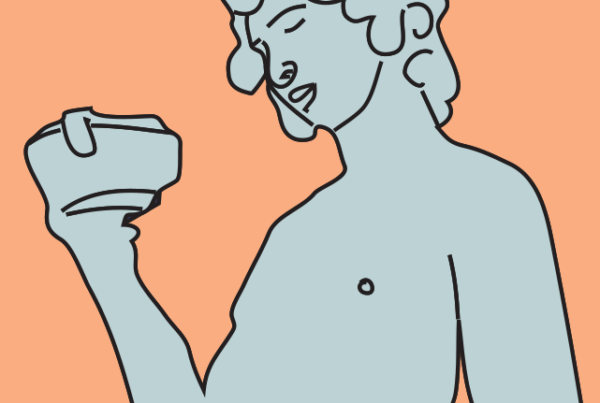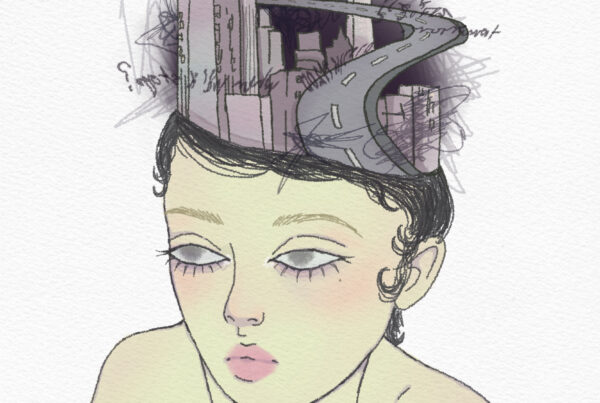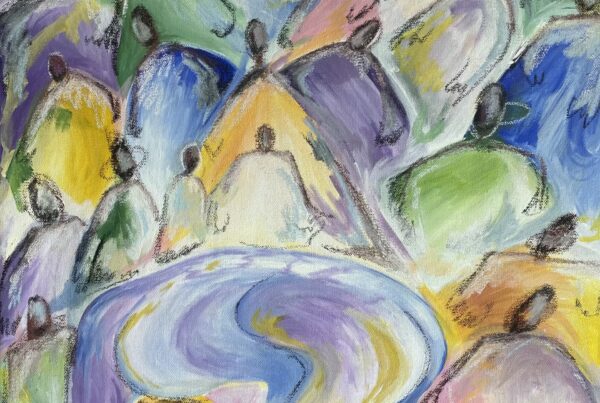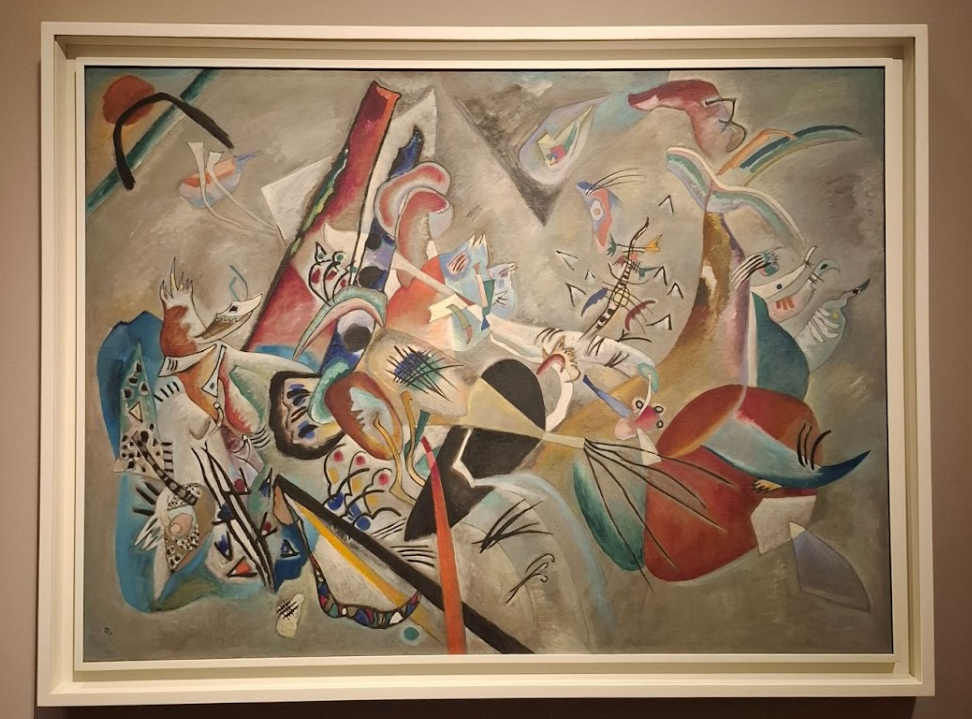
There is a moment, somewhere halfway through the Kandinsky exhibition at H’ART Museum, Amsterdam, where you wonder if you’re still seeing the paintings of a single man.
The exhibit, eponymously titled Kandinsky, is a collaboration between H’ART and the Centre Pompidou at Paris, displaying about 60 art pieces spanning the Russian-born artist’s life across countries, historical events, and art movements. His journey starts in the late 19th century in Munich, Germany, where he left to pursue art at the age of thirty after a successful but unsatisfactory career in law and economics. His early works carry the unsophisticated, childlike wonder of a starting out artist: while heavily impressionistic in style, Kandinsky paints parks, sea ports, and boats in canals with thick brushstrokes and primary colours, giving them a simple, relatable form that make them easy to look at. From the get-go I feel a connection to him – as if I myself have walked down that park, stood staring at that sea, sat in that boat.
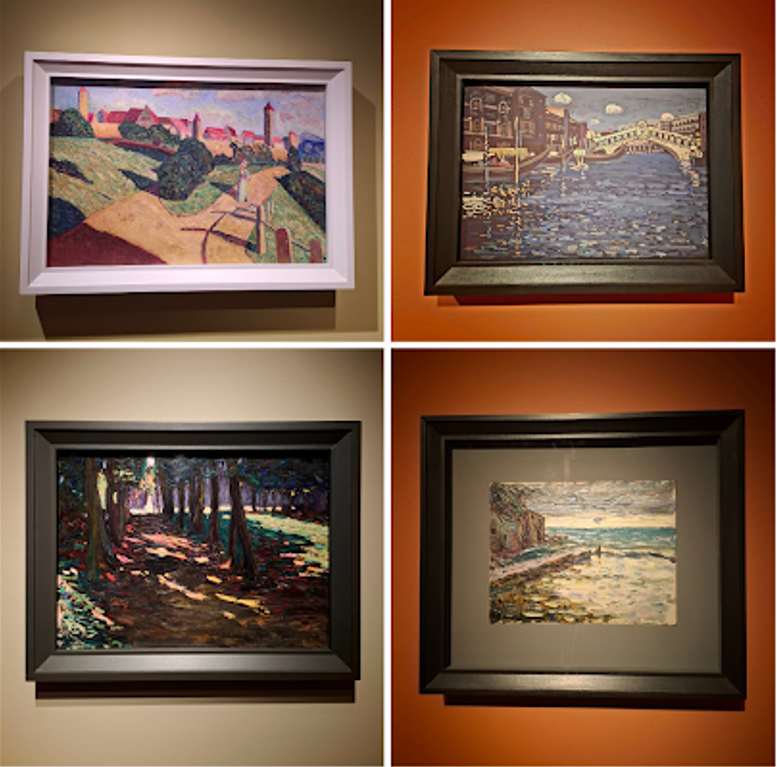
Wassily Kandinsky, from top left to bottom right: Old Town II, 1902; Memory of Venice, 1904; Parc de Saint Cloud, 1906; and Rapallo, Stormy Sea, 1906
Unlike his initial paintings, Kandinsky’s life in the early 1900s was far from simple and straightforward. Forced to leave Germany after the outbreak of the First World War, he returned to Moscow, Russia, only to find himself not quite fitting in. Kandinsky was troubled by the increased materialism invading both Soviet society and art at large, and felt that art should do more than just reproduce the world. “There is no must in art, because art is free.” To him, art served not the body but the soul; it was meant to communicate something spiritual, something beyond the realm of reality. Driven by this “inner necessity” to create art free from meaningless rules and materialistic influences, Kandinsky took his first steps into abstractionism.
For someone wildly confused by abstract art on many occasions before, Kandinsky’s work holds a strange familiarity to me even as he lets go of concrete style and form. Impression V (Parc), one of my favourites from the collection, makes it clear that Kandinsky intended for his art to say something, even if it didn’t say everything. What it says – this, he lets the audience decide. A tornado of colours across the canvas, a horseman’s silhouette on the side, just a suggestion of two soldiers walking through the haze. Better yet, you can also decide what it says and why. Standing amidst art school students and museum aficionados seriously taking notes and discussing symbolism, I – and a friend accompanying me to the exhibit – feel rather out of place. But looking at In Grey, we decide the two figures on the top right corner are probably saying:
“Hey! Where do you think you’re going without making your bed?”
“Mom, I moved out a year ago.”

Wassily Kandinsky, In Grey, 1919
In 1921, Kandinsky returned to Munich, where he taught at the Bauhaus School of art and architecture. These were his most productive years as an artist when he created 250 paintings in the renowned Bauhaus style. The exhibit displays a room full of the life-sized Salon de Réception, a series of murals that Kandinsky painted with his students in 1922. Much of it was lost during the Second World War but then reconstructed under the watchful eye of his wife, Nina Kandinsky. At Bauhaus, Gestalt psychology informed discussions around the use of points and line forms to enrich the gradation of paintings (Düchting, 2000). This was where Kandinsky’s art style began incorporating geometrical elements, particularly the circle, half-circle, and straight line. In On White, he breaks down paintings into their most fundamental elements – colour, line, and form – to show what they communicate on their own before they are brought together.
“Everything starts with a dot,” Bink van Vollenhoven narrates in the background of a video installation about the artist’s life. But the words are Kandinsky’s, probably said in one of his lectures to convey how anyone, even a non-artist, can confidently paint a dot on a canvas. The dot is just the starting point of any painting, and it can be turned to any shape or form, like a circle. Circles are an important motif in this era of paintings, signifying Kandinsky’s belief in life being cyclical – whole, infinite, and always ending where it starts. A circle, too, is a single brushstroke that moves across time and space to end exactly where it starts.
Around this time, Kandinsky established a close-knit friendship with Austrian composer and music theorist Arnold Schönberg. “The way you compose, I want to paint,” he wrote to him in a letter. Indeed, Kandinsky experienced a unique condition called synesthesia; colours held sounds for him, and words held colours. He often drew from the lexicon of music – impressions, compositions, and improvisations – to name his works according to their format, the time they took to produce, and his symphonic inspirations. In On the Points, the lines appear like the strings of an instrument, the watered-down splotches of purple, beige, and red flow into one another like visual chords, and every change in shade corresponds to a different note. There is no music playing anywhere in the museum, but I can hear it nonetheless.
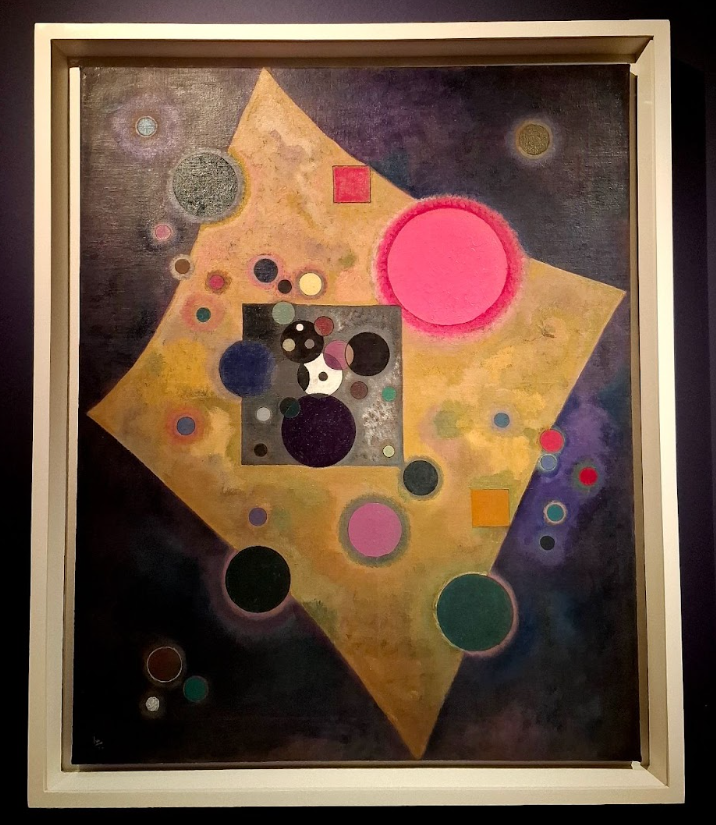
Wassily Kandinsky, Accent on Rose, 1926
All too quickly, Kandinsky’s time in Germany came to a close. The Nazis labelled him a “degenerate artist” and shut down the Bauhaus, forcing him to flee to France, where he would go on to live till the end of his years. Cocooned in a studio apartment in suburban Paris, Kandinsky’s geometric triangles and harsh lines gave way to pastel hues and free-floating orbs. He drew inspiration from biomorphism, painting objects resembling embryos, larvae, or invertebrates, a minuscule population embodying the living. In Colourful Ensemble, multi-colored jewels stud the pale blue borders like a constellation in a microcosm. Instrument-like forms scatter across the expanse: the valves of a trumpet, the head of a guitar, a three-stringed harp. Other shapes resemble microscopic organisms like flagella, ribosomes, and amoebae.
At first glance, too much seems to be happening all at once. But the longer you look, the more the chaos shifts to harmony: slowly, gradually, the disparate entities find their rightful place next to each other, and the mess somehow starts to make sense. The chaos gains structure.
The 20th century was a period of enormous change – and Wassily Kandinsky was right at the heart of it, trying to capture that change in his paintings. At this time of unending global conflict, where was he not present? He was in Russia at the time of the revolution, in Germany when the Nazis took over, in France when the capital was liberated. His art carried the human soul through such times of unspeakable distress. And, as it seems, continues to do so even today.
Kandinsky | Exhibited at H’ART Museum, Amsterdam 19 June 2024 – 10 November 2024
There is a moment, somewhere halfway through the Kandinsky exhibition at H’ART Museum, Amsterdam, where you wonder if you’re still seeing the paintings of a single man.
The exhibit, eponymously titled Kandinsky, is a collaboration between H’ART and the Centre Pompidou at Paris, displaying about 60 art pieces spanning the Russian-born artist’s life across countries, historical events, and art movements. His journey starts in the late 19th century in Munich, Germany, where he left to pursue art at the age of thirty after a successful but unsatisfactory career in law and economics. His early works carry the unsophisticated, childlike wonder of a starting out artist: while heavily impressionistic in style, Kandinsky paints parks, sea ports, and boats in canals with thick brushstrokes and primary colours, giving them a simple, relatable form that make them easy to look at. From the get-go I feel a connection to him – as if I myself have walked down that park, stood staring at that sea, sat in that boat.

Wassily Kandinsky, from top left to bottom right: Old Town II, 1902; Memory of Venice, 1904; Parc de Saint Cloud, 1906; and Rapallo, Stormy Sea, 1906
Unlike his initial paintings, Kandinsky’s life in the early 1900s was far from simple and straightforward. Forced to leave Germany after the outbreak of the First World War, he returned to Moscow, Russia, only to find himself not quite fitting in. Kandinsky was troubled by the increased materialism invading both Soviet society and art at large, and felt that art should do more than just reproduce the world. “There is no must in art, because art is free.” To him, art served not the body but the soul; it was meant to communicate something spiritual, something beyond the realm of reality. Driven by this “inner necessity” to create art free from meaningless rules and materialistic influences, Kandinsky took his first steps into abstractionism.
For someone wildly confused by abstract art on many occasions before, Kandinsky’s work holds a strange familiarity to me even as he lets go of concrete style and form. Impression V (Parc), one of my favourites from the collection, makes it clear that Kandinsky intended for his art to say something, even if it didn’t say everything. What it says – this, he lets the audience decide. A tornado of colours across the canvas, a horseman’s silhouette on the side, just a suggestion of two soldiers walking through the haze. Better yet, you can also decide what it says and why. Standing amidst art school students and museum aficionados seriously taking notes and discussing symbolism, I – and a friend accompanying me to the exhibit – feel rather out of place. But looking at In Grey, we decide the two figures on the top right corner are probably saying:
“Hey! Where do you think you’re going without making your bed?”
“Mom, I moved out a year ago.”

Wassily Kandinsky, In Grey, 1919
In 1921, Kandinsky returned to Munich, where he taught at the Bauhaus School of art and architecture. These were his most productive years as an artist when he created 250 paintings in the renowned Bauhaus style. The exhibit displays a room full of the life-sized Salon de Réception, a series of murals that Kandinsky painted with his students in 1922. Much of it was lost during the Second World War but then reconstructed under the watchful eye of his wife, Nina Kandinsky. At Bauhaus, Gestalt psychology informed discussions around the use of points and line forms to enrich the gradation of paintings (Düchting, 2000). This was where Kandinsky’s art style began incorporating geometrical elements, particularly the circle, half-circle, and straight line. In On White, he breaks down paintings into their most fundamental elements – colour, line, and form – to show what they communicate on their own before they are brought together.
“Everything starts with a dot,” Bink van Vollenhoven narrates in the background of a video installation about the artist’s life. But the words are Kandinsky’s, probably said in one of his lectures to convey how anyone, even a non-artist, can confidently paint a dot on a canvas. The dot is just the starting point of any painting, and it can be turned to any shape or form, like a circle. Circles are an important motif in this era of paintings, signifying Kandinsky’s belief in life being cyclical – whole, infinite, and always ending where it starts. A circle, too, is a single brushstroke that moves across time and space to end exactly where it starts.
Around this time, Kandinsky established a close-knit friendship with Austrian composer and music theorist Arnold Schönberg. “The way you compose, I want to paint,” he wrote to him in a letter. Indeed, Kandinsky experienced a unique condition called synesthesia; colours held sounds for him, and words held colours. He often drew from the lexicon of music – impressions, compositions, and improvisations – to name his works according to their format, the time they took to produce, and his symphonic inspirations. In On the Points, the lines appear like the strings of an instrument, the watered-down splotches of purple, beige, and red flow into one another like visual chords, and every change in shade corresponds to a different note. There is no music playing anywhere in the museum, but I can hear it nonetheless.

Wassily Kandinsky, Accent on Rose, 1926
All too quickly, Kandinsky’s time in Germany came to a close. The Nazis labelled him a “degenerate artist” and shut down the Bauhaus, forcing him to flee to France, where he would go on to live till the end of his years. Cocooned in a studio apartment in suburban Paris, Kandinsky’s geometric triangles and harsh lines gave way to pastel hues and free-floating orbs. He drew inspiration from biomorphism, painting objects resembling embryos, larvae, or invertebrates, a minuscule population embodying the living. In Colourful Ensemble, multi-colored jewels stud the pale blue borders like a constellation in a microcosm. Instrument-like forms scatter across the expanse: the valves of a trumpet, the head of a guitar, a three-stringed harp. Other shapes resemble microscopic organisms like flagella, ribosomes, and amoebae.
At first glance, too much seems to be happening all at once. But the longer you look, the more the chaos shifts to harmony: slowly, gradually, the disparate entities find their rightful place next to each other, and the mess somehow starts to make sense. The chaos gains structure.
The 20th century was a period of enormous change – and Wassily Kandinsky was right at the heart of it, trying to capture that change in his paintings. At this time of unending global conflict, where was he not present? He was in Russia at the time of the revolution, in Germany when the Nazis took over, in France when the capital was liberated. His art carried the human soul through such times of unspeakable distress. And, as it seems, continues to do so even today.
Kandinsky | Exhibited at H’ART Museum, Amsterdam 19 June 2024 – 10 November 2024

